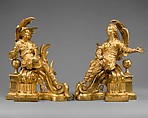Pair of firedogs
Firedogs with paired figures of a Chinese man and woman enjoyed a certain popularity in the mid-eighteenth century. The present pair, with each figure seated before a curved palm branch on a twisted S-shaped scroll supported by a truncated fluted column beside a finial, is the later of two models that incorporate these particular figures. On the earlier, fully rococo version, they sit before a curved balustrade atop a boldly asymmetrical C-shaped scroll. One example of the earlier model is signed by the goldsmith and bronze worker François-Thomas Germain (1726–1791), and others are thought to derive from it.[1] Another example of the present model is in the Musée des Arts Décoratifs, Lyons. Daniel Alcouffe has proposed that its combination of rococo (the Chinese figures, scrolls, and palms) and neoclassical motifs (column and finial) indicates a date of about 1760–70.[2] Eriksen has suggested a slightly narrower period: about 1760–65.[3] On a similar pair of firedogs in the collection of Mr. and Mrs Charles Wrightsman, New York, the figures are reversed.
The Chinese female figure also appears with small variations in both gilt and patinated forms on several mid-eighteenth-century clocks with works by various clockmakers.[4]
[Bill Rieder, 1984]
Footnotes:
[1] C. Briganti, Curioso itinerario delle collezioni ducali parmensi, Parma, 1969, p. 58.
[2] D. Alcouffe, Louis XV: Un Moment de perfection de l'art français (exhib. cat.), Paris, Hôtel de la Monnaie, 1974, no. 439.
[3] S. Eriksen, Early Neo-classicism in France, London, 1974, p. 357, pl. 221.
[4] An example with a patinated figure was in the Wildenstein and Ojjeh collections (sale, Sotheby's, Monte Carlo, June 25, 1979, lot 58).
Due to rights restrictions, this image cannot be enlarged, viewed at full screen, or downloaded.

